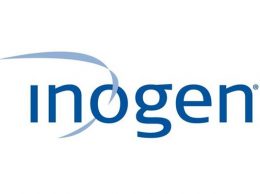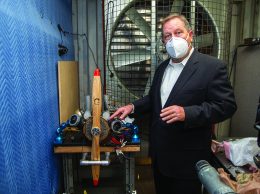Inogen shares stumble after $70.5M initial public offering
IN THIS ARTICLE
- Banking & Finance Topic
- Stephen Nellis Author
By Stephen Nellis Friday, February 21st, 2014
Shares of Goleta-based Inogen settled into the low $15 range as the Business Times went to press Feb. 19 after the company raised $70.5 million in an initial public offering that priced at $16, the low end of its expected range.
Inogen makes portable oxygen concentrators for medical patients and was spun out of UC Santa Barbara in 2001 by a group of undergraduate students. Inogen underwent a major overhaul in 2009, switching to selling and renting its devices directly to consumers. In its filings, the company said it is the only portable oxygen concentrator in the U.S. that sells directly to its customers.
After underwriting commissions for the IPO, Inogen raised $52.5 million in capital. The company’s existing shareholders, which include several private-equity firms as well as the UCSB Foundation, netted $13.1 million.
In addition to selling shares, the company changed some of the disclosures it made to investors, pointing out its steep reliance on government and private insurance programs for 41 percent of its total revenue in 2012.
“We depend upon reimbursement from Medicare, private payors and Medicaid for a significant portion of our revenue, and if we fail to manage the complex and lengthy reimbursement process, our business and operating results could suffer,” the company said in its disclosures.
Inogen has come to depend especially heavily on Medicare. In 2008, it bought an obscure firm called Comfort Life Medical Supply that had a Medicare billing number and few other assets. In 2011 and 2012, the company got about a quarter of its total revenue from Medicare reimbursements. By the first three quarters of 2013, about 28.7 percent, or $15.9 million, of Inogen’s revenue came specifically from Medicare.
At the same time, Medicare has implemented a new competitive bidding program that drastically cut how much it pays for durable medical equipment such as Inogen’s oxygen concentrators. The bidding program has been rolled out in certain groups of cities, with the entire country slated for inclusion by 2016.
Under the program, all suppliers submit bids until enough bids have been received to supply the market. After some statistical weighting, Medicare lines up the bids, picks the median and pays that to all suppliers.
Inogen fared well in winning contracts in the first two bidding rounds. The company said it believes that about 75 percent of oxygen suppliers were eliminated in the first round of competitive bidding, and it believes that upcoming results will be similar. Inogen won contracts in six out of nine cities in the initial round of bids. In the second round, it won contracts in 89 out of 100 cities. The contracts, however, last for three years. In the re-bidding process for the first group of cities, Inogen lost out and will now only have contracts in three of nine cities.
The bidding process has sharply cut the amount that Medicare pays out. According to Inogen’s estimates, Medicare only paid out 69 percent of its standard price for stationary and portable oxygen systems during the first round of bidding. That figure dropped to 59 percent after the second round of bidding. When the first round of cities was re-bid, the figure inched down to 58 percent of Medicare’s standard payment.
On top of the price reductions, the Medicare rules also allow payment to Inogen for only three years. After that, Inogen is required to provide service and support to the oxygen customer for two more years, even though it is not paid for those years. After five years, the customer can request a new concentrator and the cycle starts over again.
The company said that it believes “oxygen payment rules will continue to negatively affect our net revenue on an ongoing basis, as each month additional customers reach the 36-month capped service period, resulting in potentially two or more years without rental income from these customers. We cannot state with certainty the number of patients in the capped rental period or the potential impact to revenue associated with patients in the capped rental period.”
Inogen is also the first company in the Tri-Counties to go public under new, looser disclosure rules brought about by the JOBS Act. The company took advantage of provisions that allowed it to file a secret draft of its paperwork with the U.S. Securities and Exchange Commission before announcing its IPO and is disclosing less data about executive pay than it otherwise would have to.
Inogen has disclosed that it has serious problems with its internal financial controls. Under the JOBS Act, however, it will not be required to have an accounting firm test those controls once they are fixed. “We are in the very early stages of the costly and challenging process of compiling the system and processing documentation necessary to perform the evaluation needed to comply” with accounting rules, the company said in a filing. “[I]f we identify one or more material weaknesses in our internal control over financial reporting, we will be unable to assert that our internal controls are designed and operating effectively, which could result in a loss of investor confidence in the accuracy and completeness of our financial reports.”
Inogen notched 354 percent revenue growth between 2009 and 2012, bringing 2012 sales to $48.6 million and eking out a modest profit. For the first nine months of 2013, revenue expanded to $55.7 million, and operating profits stood at $3.9 million.
The company’s investors include Novo A/S, Versant Ventures, Accuitive Medical Ventures, Avalon Ventures and Arboretum Ventures. J.P. Morgan acted as bookrunner and was joined by Leerink Partners, William Blair and Stifel.
[Editor’s Note: This story has been updated to reflect the dates of Inogen’s closing stock prices as the Business Times was going to press.]









